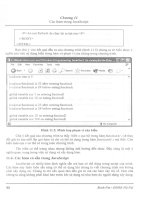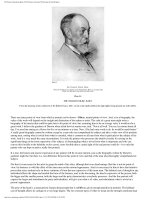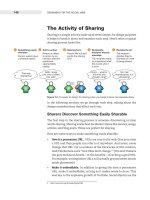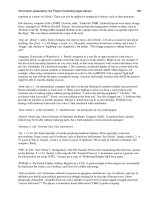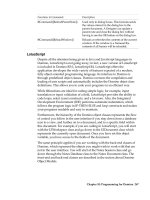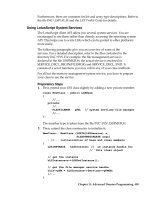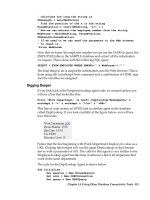cyberage books the extreme searcher_s internet handbook phần 9 docx
Bạn đang xem bản rút gọn của tài liệu. Xem và tải ngay bản đầy đủ của tài liệu tại đây (569 KB, 30 trang )
Skills
To build a Web site with the minimalist approach (using templates on a free
Web site service) requires only the ability to follow step-by-step instructions.
Beyond that, the ability to use (or learn how to use) an HTML editor will be
needed and ability to work with graphics will be useful. Be aware that the use
of graphics software can be addictive, and, as well as using it for your professional
work, you may find yourself up at 3
A.M.fixing the cracks and tears in that photo
of your great-grandfather and adding feathered edges, drop-shadows, and other
special effects to your pictures.
If you are new to using HTML editors and graphics software, there are a
number of ways to learn. Your choice of ways will probably depend upon your
own learning styles. Most programs you purchase will have a built-in tutorial,
and if you commit an hour or so you can be on your way. If you are willing to
commit several hours, you will probably find yourself in quite good control
214
T
HE
E
XTREME
S
EARCHER
’
S
I
NTERNET
H
ANDBOOK
Dreamweaver
Figure 10.1
of the program. There are also tutorials available on the Web for most popular
programs, and they sometimes provide a more simplified, yet effective, approach
to Web page editing and graphics software. Do a Web search for the name of
your program and the word “tutorial” and you will probably find several. There
are also numerous books and classes available for the more popular programs.
The alternative to using an HTML editor is to learn to write HTML code.
Most people would probably consider this the hard way, but it can actually be
fun. (Then again, some people also consider jumping into an icy river on New
Years Day “fun.”) For most people, starting with a Web page editing program
makes the most sense, but as you get into Web page building, you eventually
may want to learn the basics of HTML because of the added control it can give
you. (In the interest of full disclosure, the author admits to having had fun
writing HTML code.)
Where to Publish
Among the main options for places where the individual Web site builder may
place a Web page are the following: on a Web hosting service with your own
domain name, on your organization’s server, or on one of the “free Web site” sites.
Your Own Domain on a Web Hosting Service
For someone who owns a company and/or needs to make the most pro-
fessional impression, having one’s own domain name is the way to go. The
easiest way to get started at this level is to choose a Web hosting (virtual
hosting) company and place your site on their server. These companies can
easily be located through their ads in computer magazines, a yellow pages
directory, or a Web search. There are numerous directories specifically of
Web hosting services. To locate these directories, use the following Open
Directory category (at or use the Directory tab on Google):
Computers > Internet > Web Design and Development > Hosting > Directories
Web host services typically charge from $15 to $20 per month for basic
service and will also lead you through the process of getting your own
domain name, which requires a registration fee of around $70 for the first
two years. One of the big advantages of these services is that they handle
most of the paperwork of the domain name registration. Compare the ads,
call their toll-free numbers, and talk to two or three of them, partly to get a
feel for their degree of customer service orientation.
215
B
ECOMING
P
ART OF THE
I
NTERNET
: P
UBLISHING
Putting Your Site on Your Organization’s Server
If you are in an academic institution, there is a good chance that your
institution may provide free Web space for you. For other organizations,
there may be similar possibilities depending upon your purpose and the
nature of the organization. Do not be surprised if you are presented with a
list of criteria that must be met, with regard to both content and format. If
you are a faculty member at a university, you may easily be assigned Web
space with minimal restrictions and the permission to upload your pages
when and as you like. At the K-12 level, there is a very good chance that
there will be cooperation and enthusiasm for teachers or others to create
school and classroom pages. In other situations, it may not be as easy, and
there are situations where you will encounter institutional Webmasters with
requirements that make little sense. Fortunately, a larger proportion of people
in charge of organizational sites are realistic and helpful. If you are in a
commercial environment, do not expect to have a page of your very own
loaded on a company Web site.
Free Web Page Sites
For many people who want to get started, using a free Web site service is
an excellent starting place. Even if you are planning to move up to placing
your site on your organization’s server or to having your own domain name
on a hosting service, these free Web site services provide a good initiation.
Free Web sites are available from a variety of sources. The ISP (Internet Service
Provider) you use at home may provide a free site for subscribers. There are
also commercial sites that specialize in providing free space. You pay for these
by putting up with the ads that will come along when your page is displayed,
but it is often a good bargain. They usually also offer upgrades (that avoid the
ads) for a relatively small monthly fee. These are the leading free Web site
services:
GeoCities (a part of Yahoo!)—
Tripod—
Angelfire—
Each of these provides 15–20 megabytes of storage, enough for a very sub-
stantial Web site. They also provide templates that can be used, HTML edi-
tors, and uploading capabilities, and they allow you to upload pages you have
created elsewhere, such as in another HTML editor. These sites also make it
easy to place features such as the following on the pages you create: photos,
216
T
HE
E
XTREME
S
EARCHER
’
S
I
NTERNET
H
ANDBOOK
a counter, news headlines, weather for places you choose, online messages, and
guest books. In most cases, you will have at least a little control over the kinds
of ads that appear by your choice of the interests or communities that you select
as part of the sign-up procedure.
S
ITES TO
H
ELP
Y
OU
B
UILD
Y
OUR
W
EB
S
ITES
There are thousands of Web sites that provide help in building Web pages.
They range from the tutorials already mentioned to sites that provide specific
features that you can place on your pages (such as graphics and JavaScript
scripts) to sites that bring together a wide collection of a variety of tools. The
following three representative sites are sites that the beginner may want to
explore, particularly to get a feel for the kind of help that is out there.
217
B
ECOMING
P
ART OF THE
I
NTERNET
: P
UBLISHING
Example of a Geocities Template
Figure 10.2
Webmonkey
/>Webmonkey is especially strong on tutorials for a wide variety of things
you might want to place on your page. Look particularly at the Beginners page.
Most of the content of this site is written by the Webmonkey staff, and you
typically will not find links here to other resources.
Reallybig.com: The Complete Resource for All Web Builders
Reallybig.com contains over 5,000 links of use to both the beginner and the
advanced builder, including resources for “free scripts, CGI, counters, fonts,
HTML, Java, clipart, animation, backgrounds, icons, HTML editors, buttons,
photographs, site promotion, easy-to-follow Tips and Tricks, and much more.”
218
T
HE
E
XTREME
S
EARCHER
’
S
I
NTERNET
H
ANDBOOK
Webmonkey Beginners Page
Figure 10.3
About.com: Web Design
This section of the About.com site contains articles, tips, tutorials, and an
excellent collection of links to resources such as clip art collections, JavaScript
collections, Web hosting services, legal issues, and so on.
A
LTERNATIVES TO
Y
OUR
O
WN
W
EB
S
ITE
Two alternatives to easily communicating with large numbers of people are
to create a group (see Chapter 5) or to create a Weblog.
The Weblog (“blog”) alternative has found much favor in the last few years
and requires no more effort (perhaps less) than a free Web site. Discussed earlier
(Chapter 8), these tools provide an easy means to gather and distribute news,
commentary, and so forth. The main intent is to provide a place for short and
frequently updated postings. Although they lack the graphic attractiveness of
a Web site, their ease of use has been a major factor in their popularity. For a
site that provides free, easily established blogs, try Blogger:
Blogger
Blogger.com provides Weblog space for free, and you can provide the template
for your page or use a predesigned one from Blogger. Once you establish a Weblog
on Blogger, to publish an item, you just fill out a form and click Publish.
219
B
ECOMING
P
ART OF THE
I
NTERNET
: P
UBLISHING
This page intentionally left blank
221
It is hoped that the preceding chapters have provided some new and useful
ideas, information, and sites, even for the very experienced Internet user. My
final bit of advice is: “Explore!” As you use the sites I’ve mentioned, or any
site, take a few extra seconds to look around. Poke into the corners of a site,
and if it looks very promising, “click everywhere.”
—Ran Hock
“The Extreme Searcher”
C ONCLUSION
This page intentionally left blank
223
The following definitions are in the context of the Internet and are not
intended to be more generally applied.
algorithm. A step-by-step procedure for solving a problem or achieving a task.
In the context of search engines, the part of the service’s program that per-
forms a task such as identifying which pages should be retrieved or ranking
pages that have been retrieved.
ALT tag. Text associated with an image, in the HTML code of a page, that can
be used to identify the content of the image or for other purposes. Standing for
“alternate text,” it initially served the purpose of providing a description while
waiting for the image to load, but is now used more for other purposes, such as
providing a description of the image that can be read by screen-reader applications
designed to assist sight-impaired users. In some browsers, you will see this text
pop up when you hold your cursor over an image.
AND. The Boolean operator (or connector) that specifies the intersection of
sets. When used between words in a search engine query, it specifies that only
those records that contain both words (the words preceding and following the
“AND”) are to be retrieved. For example, the search expression “stomach AND
growling” would only retrieve records containing both of those words.
AOL. America On-Line, the most well-known consumer-oriented online service.
applet. A small Java program used on a Web page to perform certain display, com-
putational, or other functions. The origin of the term refers to “small applica-
tions programs.”
blog. See “Web logs.”
G LOSSARY
bookmark. A feature found in Web browsers—analogous to bookmarks used
in a book—that remembers the location of a particular Web page and adds it
to a list so the page can be returned to easily. Netscape refers to these as “book-
marks,” whereas Internet Explorer uses the term “favorites.”
Boolean. A mathematical system of notation created by 19th century mathe-
matician George Boole that symbolically represents relationships between sets
(entities). For information retrieval, it uses AND, OR, and NOT (or their equiv-
alents) to identify those records that meet the criteria of having both of two
terms within the same record (AND), having either of two terms within the
records (OR), or eliminating records that contain a particular term (NOT).
broadband. High-speed data transmission capability. In the home or office
context, usually referring to DSL (Digital Subscriber Line), cable, or T1 (or
higher) Internet access.
browser. Software that enables display of Web pages by interpreting HTML
code, translating it, and performing related tasks. The first widely used browser
was Mosaic, which evolved into Netscape. Internet Explorer is the browser
developed by Microsoft.
browsing. Examining the contents of a database,Web site, or other electronic doc-
ument by scanning lists or categories and subcategories. When a site provides this
capability, it is referred to as having “browsability.”
case-sensitivity. The ability to recognize the difference between uppercase and
lowercase alphabetic characters. In information retrieval, it means the difference
between possibly being able to recognize White as a name versus white as a color,
or AIDS as the disease versus aids as something that provides assistance.
channels. Term used by some online services to organize their services, func-
tions, and Web pages by subject area, often providing selected tools (e.g., cal-
culators), news, links, and other resources relevant to the specific topic.
classification. Arrangement of Web sites by subject area, often using a hier-
archical scheme with several levels of categories and subcategories.
224
T
HE
E
XTREME
S
EARCHER
’
S
I
NTERNET
H
ANDBOOK
225
G
LOSSARY
concept-based retrieval. Retrieval based on finding records that contain
words related to the concept searched for, not necessarily the specific word(s)
searched for.
co-occurrence. Occurrence of specific different terms within the same record.
Analyzing the frequency of co-occurrence is one technique used to find records
that are similar to a selected record.
Cookies. Cookies are small files of information generated by a Web server and
stored on the user’s computer that are used mostly for personalization of sites.
crawler. See “spider.”
dead links. Links that, when clicked, do not work (usually because the page is no
longer there or has moved to another URL, or because the URL is incorrect).
diacritical marks. Marks such as accents that are applied to a letter to indi-
cate a different phonetic value.
directory (Web). Collection of Web page records classified by subject to
enable easy browsing of the collection. “General” Web directories are those
sites that selectively catalog and categorize the broad range of sites available
on the Web, usually including only sites that are likely to be of interest to a
large number of users.
domain name. The part of a URL (Web address) that usually specifies the
organization and type of organization where the Web page is located, e.g., in
www.microsoft.com, “microsoft.com” is the domain name. Domain names
always have at least two parts, the first part usually identifying the organization
or specific machine, the second part (“com” or “uk”) identifying the kind of
organization or the country.
domain name server. A computer that converts the URL you enter into the
numerical address of a domain and identifies the location of the requested
computer.
field. A specific portion of a record or Web page, such as title, metatags,
URL, etc.
file extension. In a file name, such as letter.doc or house.gif, the part of the
file name that follows the period, usually indicating the type of file.
flame wars (flaming). Angry or strongly worded series of messages in Inter-
net groups or mailing lists.
FTP (File Transfer Protocol). Computer protocol (set of instructions) for
uploading and downloading files.
Gopher. A menu-based directory allowing access to files from a remote com-
puter. Gophers were supplanted in the mid-1990s by Web tools such as direc-
tories and search engines.
home page. The main page of a Web site. Also, the page designated by a user
as the page that should be automatically brought up when the user’s browser
is loaded.
HTML (HyperText Markup Language). The coding language used to create
Web pages. It tells a browser how to display a record, including specifica-
tions for such things as font, colors, location of images, identification of
hypertext links, etc.
Internet. Worldwide network of networks based on the TCP/IP protocol.
Invisible Web. Those pages that are not indexed by Web search engines and
therefore cannot be retrieved by means of a search on those engines.
Java. A programming language designed for use on networks, particularly the
Internet, that allows programs to be downloaded and run on a variety of
platforms. Java is incorporated into Web pages with small applications pro-
grams called “applets” that provide features such as animation, calculators,
games, etc.
JavaScript. A computer language used to write “scripts” for use in browsers
to allow creation of such features as scrolling marquees, etc.
metasearch engines. Search services that search several individual search
engines and then combine the results.
226
T
HE
E
XTREME
S
EARCHER
’
S
I
NTERNET
H
ANDBOOK
metasites. Small, specialized Web directories providing a collection of related
links on a specific topic, also know as cyberguides, resource pages, special
directories, etc.
metatags. The portion (field) of the HTML coding for a Web page that allows
the person creating the page to enter text describing the content of the page.
The content of metatags is not shown on the page itself when the page is viewed
in a browser window.
NEAR. A proximity connector that is used between two words to specify that
a page should be retrieved only when those words are near each other in the
page.
nesting. The use of parentheses to specify the way in which terms in a Boolean
expression should be grouped, i.e., the order of the operations.
newsgroup. An online discussion group. A group of people and the messages they
communicate on a specific topic of interest. More narrowly, the term refers to such
a discussion group on Usenet.
NOT. The Boolean operator (connector) that, when used with a term, elimi-
nates the records containing that term.
OR. The Boolean operator (connector) that is used between two terms to
retrieve all records that contain either term.
portal. A site that serves as a “gateway” or “starting point” for a collection of
Web resources. Portals typically have a variety of tools (such as a search engine,
directory, news, etc.) all on a single page designed so that users can designate
that page as their “start page” for their browser. Portals are often personaliz-
able regarding content, layout, etc.
precision. In information retrieval, the degree to which a group of retrieved
records actually matches the searcher’s needs. More technically, precision is
the ratio of the number of relevant items retrieved to the total number of items
retrieved (multiplied by 100% in order to express the ratio as a percentage). For
example, if a query produced 10 records and six of them were judged relevant,
the precision would be 60 percent. This is sometimes referred to as relevance.
227
G
LOSSARY
proximity. The nearness of two terms. Some search engines provide proxim-
ity operators, such as NEAR, which allow a user to specify how close two
terms must be in order for a record containing those terms to be retrieved.
ranking. The process that determines the order in which retrieved records are
displayed. Search engines use algorithms to evaluate records and assign a
“score” to records indicating the relative “relevance” of each record. The
retrieved records can then be ranked and listed on the basis of those scores.
recall. In information retrieval, the degree to which a search has actually man-
aged to find all the relevant records in the database. More technically, it is the
ratio of the number of relevant records that were retrieved to the total number
of relevant records in the database (multiplied by 100 percent in order to express
the ratio as a percentage). For example, if a query retrieved four relevant records,
but there were 10 relevant records in the database, the recall for that search
would be 40 percent. Recall is usually difficult to measure because the number
of relevant records in a database is often very difficult to determine.
record. The unit of information in a database that contains items of related
data. In an address book database, for example, each single record might be
the collection of information about one individual person, such as name,
address, ZIP code, phone, etc. In the databases of Web search engines, each
record is the collection of information that describes a single Web page.
relevance. The degree to which a record matches the user’s query (or the user’s
needs as expressed in a query.) Search engines often assign relevance “scores”
to each retrieved record with the scores representing an estimate of the rele-
vance of that record.
search engines. Programs that accept a user’s query, search a database, and
return to the user the records that match the query. The term is often used more
broadly to refer not only to the information retrieval program itself, but also
to the interface and associated features, programs, and services.
spider. Programs that search the World Wide Web in order to identify new (or
changed) pages for the purpose of adding those pages to a search service’s
(“search engine’s”) database.
228
T
HE
E
XTREME
S
EARCHER
’
S
I
NTERNET
H
ANDBOOK
start page. The page that loads automatically when you open your browser.
Also sometimes, confusingly, called your “home page.” You select what you
want your start page to be by using the “Edit > Preferences” or “Tools > Inter-
net Options” choices on your browser’s menu.
stopwords. Small or frequently occurring words that an information retrieval
program does not bother to index (ostensibly because the words are “insignif-
icant,” but more likely because the indexing of those words would take up too
much storage space or require too much processing).
submitted URLs. URLs (Internet addresses) that a person directly submits to
a search engine service in order to have that address and its associated Web
page added to the service’s database.
syntax. The specific order of elements, notations, etc., in which instructions must
be submitted to a computer system.
TCP/IP. Transfer Control Protocol/Internet Protocol. The collection of com-
puter data transfer protocols (set of instructions) used on the Internet.
Telnet. A program that lets you log on to and access a remote computer using
a text-based interface.
thesaurus. A listing of terms usually showing the relationship between terms,
such as whether one term is narrower or broader than another. Thesauri are
used in information retrieval to identify related terms to be searched.
thread. Within a group (newsgroup, discussion group, etc.), the series of mes-
sages on one specific topic consisting of the original message, replies to that
message, replies to those replies, etc.
timeout. The amount of time a system will work on a task or wait for results
before ceasing either the task or the waiting.
truncation. Feature in information retrieval systems that allows you to search
using the stem or root of a word and automatically retrieve records with all
terms that begin with that string of characters. Truncation is usually specified
229
G
LOSSARY
using a symbol such as an asterisk. For example, in some Web search engines,
town* would retrieve town, towns, township, etc.
URL (Uniform Resource Locator). The address by which a Web page can
be located on the World Wide Web. URLs consist of several parts separated
by periods and, sometimes, slashes.
Usenet. The world’s largest system of Internet discussion groups (also
called newsgroups).
videotext. Systems, developed in the 1970s, allowing interactive delivery of text
and images on television or computer screens. One of the first applications was
the delivery of newspaper content.
vortal. A specialized portal. (from V
ertical Market Portal).
Web (World Wide Web, WWW). That portion of the Internet that uses the
Hypertext Transfer Protocol (http) and its variations to transmit files. The
files involved are typically written in some variation of HTML (HyperText
Markup Language), thereby viewable using browser software, allowing a GUI
(Graphical User Interface), incorporation of hypertext point-and-click navi-
gation of text, and extensive incorporation of images and other types of media
and formats.
Web logs. Web sites, usually created by individuals, that are updated fre-
quently, usually provide links to news items elsewhere on the Web and often
contain commentary, etc., on a very specific topic.
230
T
HE
E
XTREME
S
EARCHER
’
S
I
NTERNET
H
ANDBOOK
231
Chapter 1
A Brief History of the Internet, version 3.1
/>Internet History and Growth
/>and_Growth.ppt
Hobbes’ Internet Timeline
/>The Virtual Chase:
Evaluating the Quality of Information on the Internet
/>Evaluating the Quality of World Wide Web Resources
/>Wayback Machine—Internet Archive
Direct Search
/>invisible-web.net
CompletePlanet
URL LIST
➢
United States Copyright Office
/>Copyright Web Site
Copyright and the Internet
/>~
montecin/copyright-internet.htm
Karla’s Guide to Citation Style Guides
/>Style Sheets for Citing Internet & Electronic Resources
/>The Resource Shelf
FreePint
ResearchBuzz
Internet Resources Newsletter
/>The Scout Report
Chapter 2
Yahoo!
Open Directory
232
T
HE
E
XTREME
S
EARCHER
’
S
I
NTERNET
H
ANDBOOK
➢
233
URL LIST
LookSmart
Librarians’ Index to the Internet
Search Engine Colossus
MSN
Netscape
Excite
Lycos
Voila!
Traffick: The Guide to Portals and Search Engines.
Frequently Asked Questions about Portals.
Chapter 3
The WWW Virtual Library
Search Engine Guide
➢
Internet Public Library Reference Ready Reference
/>refdesk.com
InfoMine
BUBL LINK
/>Project Gutenberg
/>Library of Congress Gateway to Library Catalogs
/>Social Science Information Gateway
Tennessee Tech History Web Site
/>Virtual Religion Index
/>ChemDex
HealthFinder
MEDLINE Plus Health Topics
/>EEVL: The Internet Guide to Engineering,
Mathematics, and Computing
234
T
HE
E
XTREME
S
EARCHER
’
S
I
NTERNET
H
ANDBOOK
New York Times Cybertimes—A Selective Guide to
Internet Business, Financial, and Investing
Resources
/>CEOExpress
Virtual International Business and Economic
Sources
/>Resources for Economists on the Internet
WebEc
/>I
3
—Internet Intelligence Index
/>Governments on the WWW
/>Foreign Government Resources on the Web
/>FirstGov
UK Online
Political Resources on the Net
FindLaw
235
URL LIST
Kathy Schrock’s Guide for Educators
/>Education World
Education Index
http://www/educationindex.com
Kidon Media-Link
Cyndi’s List of Genealogy Sites on the Internet
Chapter 4
AllTheWeb
AltaVista
or
HotBot
Teoma
Lycos
WiseNut
MSN Search
236
T
HE
E
XTREME
S
EARCHER
’
S
I
NTERNET
H
ANDBOOK
➢
Search Engine Watch
Chapter 5
Google Groups
Yahoo! Groups
Delphi Forums
ezboard
Topica
Publicly Accessible Mailing Lists
L-Soft CataList, the Official Catalog
of LISTSERV lists
/>Chapter 6
Encyclopedia.com
Encarta
237
URL LIST
➢
➢
Voila Encyclopédie avec Hachette
Encyclopedia Britannica
YourDictionary.com
Merriam-Webster Online
Dictionnaire Universel Francophone En Ligne
diccionarios.com
LEO—Link Everything Online
InfoPlease
Wayp International White and Yellow Pages
Yahoo! People Search
AnyWho
Quote Links
Bartleby
238
T
HE
E
XTREME
S
EARCHER
’
S
I
NTERNET
H
ANDBOOK
